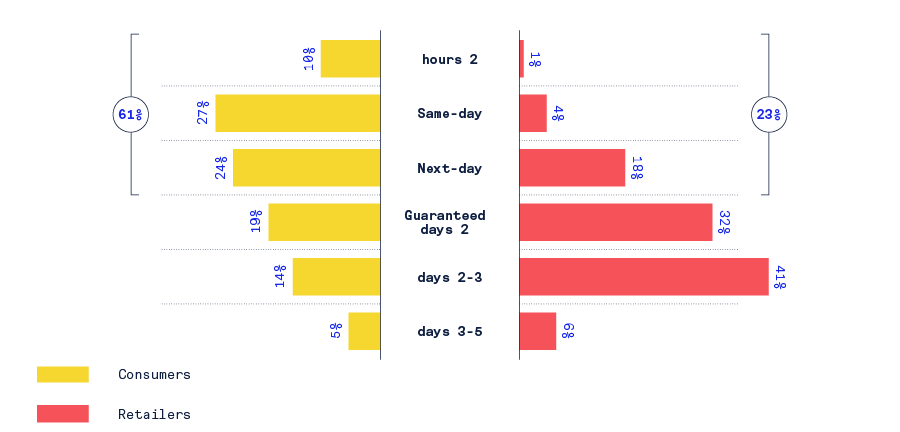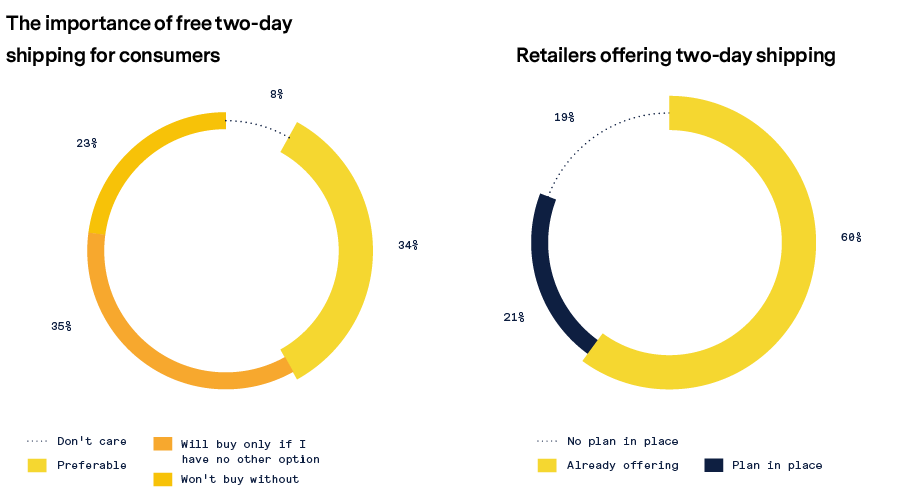According to Albert Einstein’s theory of relativity, there is no absolute frame of reference for time, and one’s experience of time is always in relation to something else. When he posited this in 1905, of course, he was talking about the speed of spacetime, but in the e-commerce landscape of 2022, he could just as easily have been discussing delivery windows.
Gone are the days when consumers were perfectly happy with the standard shipping of three to five days. Across all categories, today’s consumers want things delivered fast. While brands are scrambling to keep up with today’s onslaught of challenges, like insufficient fulfillment capacity and shipping carrier constraints, our research shows they haven’t yet gotten the memo of how consumers define “fast.” Let’s look closer at how these misaligned expectations came to be, and what brands can do about it.
Brands and Consumers Have Different Definitions of “Fast” Delivery
The trifecta of customer satisfaction has long been free shipping, price, and positive reviews. Outside of food and grocery, speed of delivery wasn’t considered all that important. That’s not the reality anymore.
Amazon, of course, was the first big retailer to roll out one-day delivery of non-grocery items, and this was seen as a harbinger for other companies. But Amazon has stacked the deck. While they can bankroll their low prices and super-fast delivery with profits from AWS and Prime, other brands have no such luxury; consumers, meanwhile, don’t care how brands are funding their services, they just want what they’ve come to expect.
The problem is, consumers came to expect extremely fast delivery sooner than most brands are prepared for: While 61% of the consumers we surveyed define “fast delivery” as next-day or same day, a whopping 77% of retailers defined it as two-day or slower. A measly 18% of brands think “fast” means next-day or faster, while more than half of consumers expect this delivery window.
Free Two-Day Shipping Is Table Stakes for Consumers, And Brands Aren’t Anteing Up
Let’s talk about two-day shipping. Once considered fast, this delivery speed is now the new standard among consumers. Of the consumers we surveyed, 92% want retailers to provide two-day shipping, and nearly one in four shoppers say free two-day shipping is essential to making a purchase. If the option isn’t there, it’s a deal-breaker.
A full 40% of the brands we surveyed don’t offer two-day shipping at all, paid or not, and about half of that group have no plans to change that. When it comes to free two-day shipping, the numbers are starker: a full 68% of the brands we surveyed don’t think free two-day shipping is a requirement to stay competitive.
This misalignment raises flags. It’s one thing to not offer a service because it’s financially and operationally difficult to do so — this makes sense from a logical business standpoint — but it’s quite another thing to remain unaware that the service is unimportant. If brands fail to internalize new delivery expectations of consumers, they risk misunderstanding their target audience, which can be a costly mistake. Such an oversight will almost inevitably lead to lost revenue and market share.
Same-Day Delivery Is Right Around the Corner as the New Standard
Consumer expectations are, unfortunately, a one-way ratchet. As we’ve grown accustomed to two-day shipping as standard practice, many consumers are starting to want things even faster: of the consumers we surveyed, 81% were more likely to purchase something if they could get it delivered the same day. The digital age has trained us to expect immediate gratification, and e-commerce isn’t exempt from this new attitude.
According to Research and Markets, the same-day delivery market in the U.S. is poised to grow by $9.8 billion over the next four years. This massive projection makes sense when you consider how much consumers value same-day delivery. According to our research, 67% of consumers are willing to pay for same-day delivery, which is particularly striking given that people have become overwhelmingly accustomed to free shipping. Speed, it seems, trumps cost for many. Meanwhile, only 25% of the brands we surveyed even offer paid same-day delivery as a service, and 64% don’t think it’s a requirement to stay competitive.
Brands Know Speed Will Be Essential in the Future, But Don’t Realize It’s Already Essential Today
Brands aren’t blind to consumers’ evolving expectations. They just don’t see how rapidly this evolution is taking place. When it comes to next-day shipping, 49% of the brands we surveyed think it’ll be important within one year and 73% think it will be important within two years. For same-day shipping, those numbers were 41% and 63%, respectively. The problem is that even “within one year” is two slow; consumers want immediate gratification, immediately.
Why This Gap Persists, and How Brands Can Close It
It’s clear why this gap between brand offerings and consumer expectations exists. The truth is that it’s arduous for brands to make faster shipping happen within the infrastructure of existing supply chains. With most brands relying on centralized warehouses in rural areas, getting goods to consumers within even two days is an operationally, strategically, and financially challenging proposition.
That doesn’t mean that brands need to walk away from the existing fulfillment strategy and infrastructures they’ve spent years building and invested millions in, but it is time for them to augment their operations with a robust distributed fulfillment strategy. They can do this by finding a long-term fulfillment partner who can strategically distribute their inventory in close proximity to their customers, dramatically reducing delivery distances and costs. By leveraging robotic automation, this sort of distributed fulfillment strategy can even promise on-demand deliveries at unit economies that beat standard shipping.
Einstein, once again, sums things up neatly: “We cannot solve our problems with the same thinking we used when we created them.” It’s time for brands to enter the brave new world of delivery expectations, and they’ll need a fundamentally different approach to do that.





